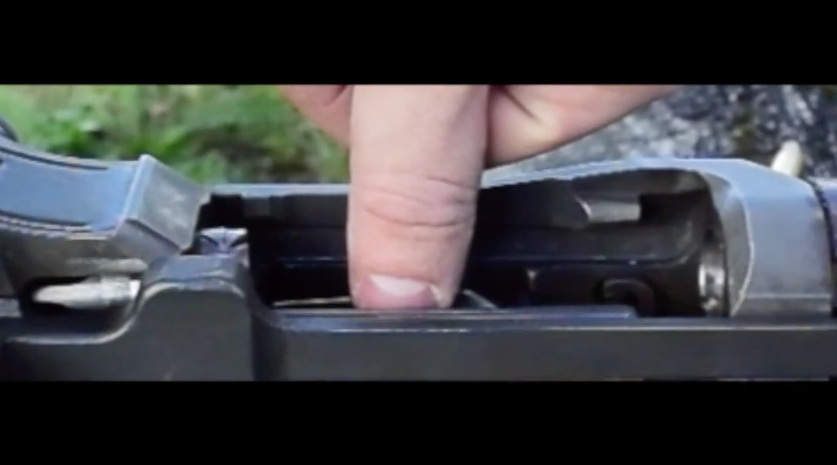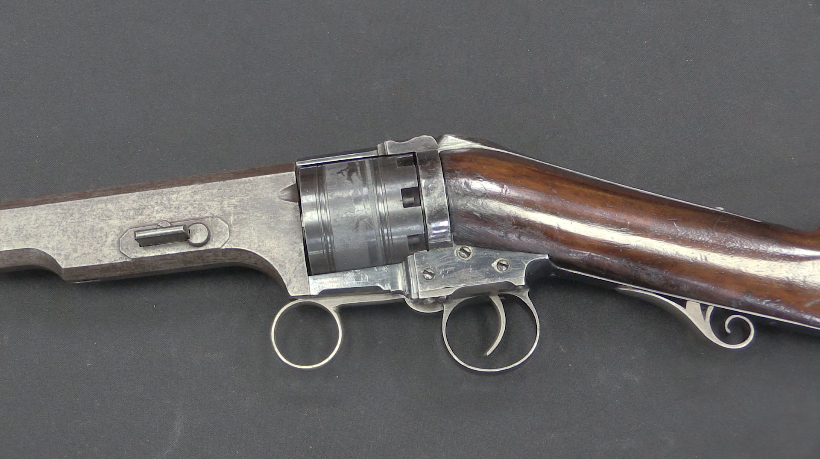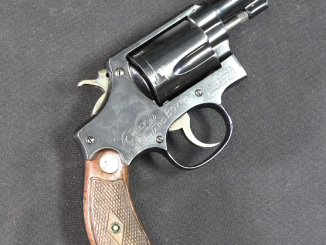I’ve been taking a lot of big pistols to the (alleged) BackUp Gun Match, and I figured it was time to try out something that actually would quality as a back-up gun. So, I got my hands on one of NAA’s .22 Mini-Revolvers. This is the smallest practically shootable “real” gun made, and they are relatively popular with some people as a deep concealment pistol.
They are available in .22 Short, .22 LR, and .22 Magnum, with a wide variety of options and features. What I am using today is a very basic example. It has a .22 Magnum 5-shot cylinder, basic wood grips, and is single action only with a sheath trigger. It has a 1.625″ (41mm) barrel and weighs 6.5 ounces (184 g). It has a front sight and no rear sight, and is effectively impossible to aim at any reasonable distance. So, let’s see it f it is still better than a Taurus Curve!
Epilogue: I placed 27th of 31 shooters (87th percentile), with a total score of 2 point. With the Curve – including the fact that I used a fully-functional HiPoint for the last stage – I scored -4 overall. That was not on the same course of fire, so it’s not strictly comparable, but I think it is highly suggestive. I also placed worse relative to the field with the Curve, at 37th of 41 (90th percentile). The Mini-Revolver is slow to shoot, underpowered, and essentially impossible to aim, but it is well made and reliable. The Curve has much more oomph, but it does not run reliably at all. Given a terrible choice between only these two guns, I would be very temped to take the NAA simply because I know it will at least work.




Interesting test for the NAA Mini Revolver. Perhaps a better option for deep concealed carry would be the NAA “Ranger II”. Still a 5-shot .22 Magnum, it does feature a longer 2 1/2″ barrel, a rear sight notch, and a break-top action, which does at least offer the possibility of a reload.
Good choice for inside phone booths.
I haven’t seen a phone booth in a long time however.
They are a lot of fun, and also quite accurate. Unfortunately, humans can’t utilize that potential accuracy.
There is an old phone booth near Baker, Nevada with weeds growing around it, never tried to make a call from it though!
I’m not a big believer in DA, but it seems to make much more sense for this category / requirement set.
Clearly a problem with over-penetration on stage 2.
Also know as a get off me gun.
This might have been a fun shoot but not really a legitimate test of that revolver.They are meant for across the table ranges not 40 yards. Given that, I would have to disagree that there are better choices. I challenge Ian to shoot the same course of fire with the NAA and what he feels wold be a better choice and having to draw from concealment.
I suppose the choice depends on the size limitations and what kind of concealment the gun has to be drawn from. In the kind of diminutive size of the Mini-Revolver there are not too many choices and even less better ones. However, if you allow for a slightly bigger size, the number of available options increases considerably.
I agree with Ian.
One could argue there’s nothing “better” in terms of shrinking a workable firearm that shoots common ammunition, but what does that size buy you? I routinely conceal a P365 even in light, casual summer clothing. It would be even easier if I went just one size smaller (LCP Max / P3AT).
Since even the BUG match is on the clock (for good reason), any reliable semiauto or revolver that doesn’t require finding and thumbing a tiny hammer between shots would beat the NAA regardless of range. Any handgun with real sights would beat the NAA. Adjust paper scores for KE, PF, or any formula whatsoever that credits ballistic performance, and any real centerfire cartridge would beat the NAA.
The NAA is better in one area only (concealment), and objectively, substantially worse in all others. While one could think of farfetched situations (like sneaking one into prison) where only an NAA would do, that simply isn’t true of any conceivable legal, real-world circumstance.
“(…)Adjust paper scores for KE, PF, or any formula whatsoever that credits ballistic performance, and any real centerfire cartridge would beat the NAA.(…)”
From 2 inch barrel .22 Magnum and 6,35 mm Browning
http://www.ballisticsbytheinch.com/22mag.html
http://www.ballisticsbytheinch.com/25auto.html
have quite similar muzzle energy, first have bigger spread as more different versions were tested thus you can find .22 Magnum having less and having more ft-lbs.
6,35 mm Browning is not real centerfire cartridge by your standards?
As 6.35 / .25ACP was designed for the specific purpose of duplicating .22LR ballistics, absolutely not.
This is yet another instance of “Everything is a tradeoff until it isn’t.” The time when one had to choose between adequate concealability and adequate cartridge performance is long past. Modern micro-compacts chambering service cartridges are smaller and lighter than many historical “pocket pistols”; while .22s and .25s can be smaller still, there is no reason to choose one when a 9mm or .380 is concealable under any clothing one would wear outside the house.
That said, if all else were equal, a 6.35mm Browning would absolutely be more effective in a timed shooting match than a single action revolver with a tiny hammer spur.
“…As 6.35 / .25ACP was designed for the specific purpose of duplicating .22LR ballistics,…”(С)
“Sometimes, when You speak, some may have the feeling that You are delusional…” (C) 😉
25ACP has never been a substitute or analogue of 22LR.
It’s just a small cartridge for small pistols.
One of several more or less successful handfuls of cartridges Browning made at random.
It is too expensive and weak to replace the 22LR.
I like Ian’s “blood scoop”
Possibly underrated. The original form factor of a spur-trigger single-action coat-pocket revolver was very popular for decades, from percussion revolvers to smokeless. They are surprisingly handy. The long yet skinny form is well shaped for pocket carry and drawing.
A better test of that form factor would be the NAA Mini-Master which has a 4 inch barrel, real sights, and enlarged grip. The Mini-Master is actually lighter and smaller than an original pocket revolver like the Remington .31 caliber 1863 model.
“(…)from percussion revolvers to smokeless(…)”
Also SHARPS derringer lacked trigger guard, see 1st photo from top
https://truewestmagazine.com/article/an-ace-in-the-hole/
It was patented 1859 and Until 1874, Sharps made more than 150,000 various models of its Pepperbox pistols which suggest it found many users.
“(…)very popular for decades(…)”
Also what might surprising from modern perspective is that COLT PATERSON percussion revolver lacked trigger guard, despite not being pocket size. One explanation I heard is that it was supposed to make it look like it height would be lesser and thus better suited for users accustomed for proportions of single-shot percussion pistols. I do not enough knowledge regarding percussion revolvers to say if it is true or not thus I ask: Can anybody deny or prove that?
Would you like to try a Beretta 21A .22 l.r. on that same course better sights 7 rd mag, 2 mags available for reloads and comparable barrel length.
“This is the smallest practically shootable “real” gun made”
Currently made. There’s the double action “Baby” revolver which is slightly smaller and fires .22 short. You can find catalog listings for it at the start of the 20th century up till at least the 1920s. I’m frankly surprised there hasn’t been a video on it yet.
Do you mean what unblinkingeye describes as Kolb Baby Hammerless see photos
https://unblinkingeye.com/Guns/KolbBH/kolbbh.html
?
Yes
Ok, after some searching I found similarly sized European-revolver namely Fraipont Emile CLIC CLAC which has peculiar shape of grip, see photos here http://littlegun.be/arme%20belge/artisans%20identifies%20e%20f/a%20fraipont%20gb.htm
The usefullness of these pistols is something I’ve always found highly questionable.
First, there’s the question of whether or not you can hit anything you’re not already touching, and second… If you are touching what you need to shoot, there’s the minor problem of all that crap sticking out of it, having to cock it, and the unobstructed trigger. It is not a pistol I want to take into a wrestling match, and I think that the practicalities of using one of these or anything else of the sort is going to be fraught with issues.
You’re going to use a pistol as a “get off me” tool, you need to have something you can conceal, get at quickly, and then just press up against your assailant and pull the trigger quickly and repeatedly until they either actually get off you, or expire. These little mini-revolvers fail on the “pull out, manipulate while struggling, shoot”. That exposed hammer is going to get caught on clothes, the exposed trigger is going to get tripped while you struggle, and maybe not wind up shooting your assailant.
Better form factor? A hammerless revolver. Period. Preferably one with a cylinder that’s not going to get bound up by cloth, or something else.
I knew a cop in Chicago that had actually used one of these NAA pistols during a “situation”. He’d carried it in one of those little suede pocket pouches, and when he went to use it while wrestling with a suspect that was preventing him from drawing his service revolver, what he found was that getting the thing cocked was the problem. If one of his fellow officers hadn’t shown up and proceeded to beat the suspect silly with a PR-24, lavishly applied to head and upper body, he was pretty sure he’d have died that night.
I expressed doubt that the PR-24 had been as ineffective as he described; he proceeded to show me pictures of the guy that looked about like he’d been run through batting practice for the Chicago Cubs as the only ball they had. Notably, he still had fight in him, and it took two more cops to get him restrained. My comment to him after seeing how much damage they’d had to do to him, added in with what the first cop was dealing with? It would have been cheaper and kinder to shoot the fool.
That’s where I picked up the idea that a hammerless revolver in about a .38 +P+ would be a better backup. I think that’s what all the experienced cops in Chicago were carrying, in those days–Before semi-autos came in.
Why not just use a Colt Pocket Hammerless with the darn thing already cocked beforehand and with the safety catch turned off? That should take care of the problem. Apply two bullets directly to the perp’s forehead and two more to his [unmentionables], and then beat him to a jelly with a baseball bat if the man doesn’t stop after that. Just kidding.
My practice was to keep my thumb over the hammer while drawing, to keep it from snagging on clothes and also to prepare to cock it. The gun’s tiny size aids in this: the fingers are enough to control it fully; no need to wrap the thumb around the grip too.
I found it to be picky about ammo: some boxes of .22 Mag would deliver 900 fps and good accuracy, others 700 fps and tumbling.
Still woefully underpowered for self-defense, of course. It’s in the “better than no gun at all” category, and even that is debatable.
I actually saw someone OCing one of these yesterday, albeit not sure what caliber it was. I’d really like to get one of the belt buckles, although a punch dagger belt buckle would probably be more effective. But the belt buckle holster would be amusing to see how many ppl notice it & just up my carry gun count by 1.
I thin a Baby Browning [ 25acp ] beats that hands down . And the yardage for shooting that kind of gun should be know more than the digits on one hand ..
This revolver is a good tool.
Its main drawback is the cartridge.
It is difficult to say what they were guided by, but 22LR is incomparably more appropriate.
And for better accuracy, there is a foldable holster handle. With which it turns from a suicide weapon into a perfectly usable device.
IMHO A double-acting revolver (like the Velodog) would be much preferable. But they were afraid that they would not be able to produce such a complex product. 😉
The website http://www.velodogs.com is well worth a look, they definitely are ‘Forgotten Weapons’ that seemed to work really well, with the reliability of centrefire rather than a rimfire. The section about urban crime and bicycle guns is also fascinating.
“Homeopathic 10mm” XD Still one of my least favorite guns to shoot…even with small woman hands, it’s hard to keep fingers etc. away from the business end when it’s loaded! Good run, though, Ian. Definitely better than the Taurus Curve.
Ian, you’re blaming the arrow when it was the Indian’s fault.
The NAA Mini-Mag was designed for right-handed operation. /sarc
It bears mention that in 1992, SC State Trooper Mark Coates got into a gun battle with a 350-lb Oompa-Loompa who was carrying nothing but a Mini-Mag. The Oompa-Loompa survived four COM hits (or five; accounts vary) from Trooper Coates’ .357 revolver but his second shot with the NAA passed through the arm hole in Coates ballistic vest and penetrated to his heart, killing him.
So you mock the Mini-Mag at your own peril.
Having seen the muzzle flash .22 mag created by a 6″ AMT, I’d love to seen what Ian’s keychain fob would throw in dimmer conditions. As to impractical? Yep. Possibly even more so than a Belgian folding trigger .25 acp revolver…Only more reliable than the sample of one I ran across years ago.
Take the NAA mini to the range with a box of ammo and practice operating it smoothly and aiming it consistently at the target. You will find that at 5-7 yards you can put 5 into the center area of a paper plate with ease. Then take it through your contest again and tell us what ou think.
I own a ‘boot gun” version of this with a longer barrel. It is designed as a close-in weapon, not a target pistol.
I remembered this –
https://www.thehighroad.org/index.php?threads/actual-shootout-against-armed-killers.433867/
Try putting your support hand thumb behind the NAA’s grip for more to hold onto…